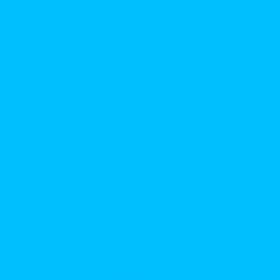Blue is one of the three primary additive colours; blue light has the shortest wavelength range (about 420-490 nanometres) of the three primary colours. The English language commonly uses "blue" to refer to any colour from blue to cyan.

A clear sky on a sunny day is coloured blue, because of Rayleigh scattering of the light from the Sun. Large amounts of water (H2O) appear blue because red light around 750 nm is absorbed as an overtone of the O-H stretching vibration. Interestingly, heavy water (D2O) is colourless, because the absorption band (~950 nm) is outside the visible spectrum.
An example of a blue colour in the RGB colour space has intensities [0, 0, 255] on a 0 to 255 scale. Blue is the complement of yellow. For this reason, blue 80A filters are used to correct for the excessive redness of tungsten lighting in colour photography.
Many languages do not have separate terms for blue and green, and in the Swedish language, the word blue was used to describe for black until the early 20th century. The modern English word blue comes from the Middle English, where it began to be used along with bleu, an Old French word of Germanic origin (possibly Old High German blao, "shining"). A Scots and Scottish English word for "blue" is blae, from the Middle English bla ("dark blue", from the Old English blæd.
Blue is associated with many air forces and navies from the colour of
their dress uniforms, navy blue for the latter. The Blue Angels are an
acrobatic flight squadron of the U.S. Navy.
Blue may denote the working class, derived from the traditional colour
of factory or shop uniforms. Blue-collar workers are industrial workers
as opposed to white-collar office workers.
In contrast to "blue collar", the phrase "of blue blood"
is used to mean "from an aristocratic background", because a
pale, untanned skin allows blue-tinged veins to show through.




